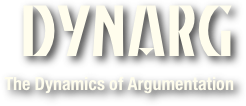

















































Project Description
Artificial Intelligence is a science that aims to implement human intelligence. For this purpose it studies and conceives the behaviour of rational agents. Pertinent information may however be insufficient or on the contrary there may be too much relevant but partially incoherent information. Different theories have been proposed for decision-making dealing with such information. However the growing development of multi-agent systems needs to handle collective decision and information coming from different sources. Moreover in multi-agent systems, agents need to interact in order to inform, convince, and negotiate with other agents. Argumentation theory is a suitable theory to support such interactions. It is a process based on the valuation of interacting arguments that support opinions, claims, proposals, decisions, etc of agents. Formally argumentation is a reasoning model based on constructing arguments and determining acceptable arguments.
Over the last ten years, interest in argumentation has expanded dramatically, driven in part by theoretical advances but also by successful demonstrations of a wide range of practical applications. DYNARG builds on a common framework recently developed in the European Sixth Framework IST project ASPIC (2003-2007).
We will address the following objectives:
1.Development of an abstract theory of dynamic argumentation theory in which arguments/conflict relations can be added/removed. In particular, we will study how acceptability semantics in argumentation theory evolve when the set of arguments/conflict relations change.
2.A framework for aggregation of argumentation frameworks for interaction among arguing agents. Since argumentation theory models interaction between different agents, some conflict relations may be expressed by several agents at the same time. Conflict relations between arguments can be considered as constraints between arguments. Thus a network of conflict relations between arguments can be constructed for each agent. We intend to use recent results on merging constraint networks to treat the case of conflict relations expressed by several agents simultaneously.
3.Development of new notions of distance between argument graph labellings, in order to formally define when the evaluation of one agent on a set of interacting arguments can be said to be “close to” or “far” from that of another. We will apply this notion to the problem of merging conflicting viewpoints of several agents.
4.Application of the dynamic of argumentation theory to dialogue between agents. We use the newly developed framework to further develop the theory of argument games developed by Prakken and Vreeswijk.



